Knavery of the Rump, 1679
The Knavery of the Rump playing cards, first published in 1679, are a satirical portrayal of Oliver Cromwell's Government. The illustrations on the cards provide a rare visual impression of the times.

The Knavery of the Rump engraved playing cards, first published in 1679, are a satirical portrayal of Oliver Cromwell's Government during the period of the Rump Parliament 1648-53. The illustrations on the cards provide a rare visual impression of the times. We see not only the military warring factions, but the humbler souls of town and countryside in traditional dress. The title card (second row) is inscribed “The Knavery of the Rump, Lively represented in a Pack of Cards. To be sold by R.T. (Randal Taylor) near Stationers Hall and at the Black Bull in Cornhill.” The backs are plain.
This pack was engraved from designs by the artist Francis Barlow, and a copy of the pack was owned by Lord Nelson. A large number of such educational packs were published during the 17th-18th centuries. A facsimile edition was published by the Aungervyle Society, printed by E. & G. Goldsmid, Edinburgh in 1886 with coloured backs and titled “A Pack of Cavalier Playing Cards” (see the box). A modern facsimile of this very rare pack is part of a range published by Harry Margary.

Above: cards from the facsimile edition courtesy Giles de Margary. The illustrations on the cards, with their strongly protagonist captions, provide, apart from their familiar sentiments of disapproval, a rare visual impression of the times. The satirical element involves presenting the personalities in various unfamiliar occupations and costumes, and we see not only the military warring factions, but the humbler souls of town and countryside in traditional dress, the waggoners, shepherds, corset-makers, carpenters and so on. The pack is, in fact, a valuable witness to a variety of aspects of mid 17th-century society. Packs can be ordered directly from www.harrymargary.com
See also: The Beggar's Opera • South Sea Bubble • Arms of English Peers • Robert Morden • Cries of London • Transformation Cards, 1811 • Marlborough's Victories • Fortune-Telling, c.1690 • Mathematical Instruments • Geistliche Karten

By Simon Wintle
Spain • Member since February 01, 1996 • Contact
I am the founder of The World of Playing Cards (est. 1996), a website dedicated to the history, artistry and cultural significance of playing cards and tarot. Over the years I have researched various areas of the subject, acquired and traded collections and contributed as a committee member of the IPCS and graphics editor of The Playing-Card journal. Having lived in Chile, England, Wales, and now Spain, these experiences have shaped my work and passion for playing cards. Amongst my achievements is producing a limited-edition replica of a 17th-century English pack using woodblocks and stencils—a labour of love. Today, the World of Playing Cards is a global collaborative project, with my son Adam serving as the technical driving force behind its development. His innovative efforts have helped shape the site into the thriving hub it is today. You are warmly invited to become a contributor and share your enthusiasm.

Leave a Reply
Your Name
Just nowRelated Articles

Pam is the Knave of Clubs
Playing cards as metaphors in 18th century art - from fate, chance and social hierarchy t...

Dr Sacheverell
Dr. Henry Sacheverell's impeachment in 1710 sparked widespread public unrest and political upheaval,...
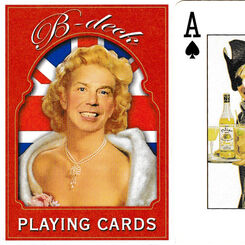
B-Deck
“B-Deck” scurrilous playing cards poking fun at a former UK prime minister.

Meal Tub Plot
Meal Tub Plot playing cards [facsimile] with 17th century sketches by Francis Barlow.

Spanish 19th century Political pack
Satirical playing cards manufactured by Francar y Cía depicting political situation.
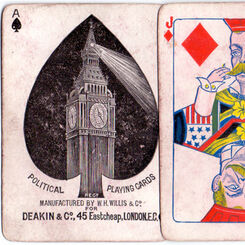
Deakin’s 3rd edition
Deakin’s Political Playing Cards 3rd edition, c.1888.

Origins Playing Cards
Rick Davidson's “Origins” playing cards is an inspired, present-day re-design of the standard Anglo-...

William Warter
William Warter's Proverbial Cards, which carry illustrations of old English proverbs, were first pub...
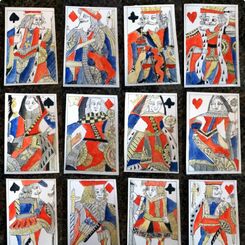
David James Binns
Hand-made “Tudor Playing Cards” by David James Binns, age 12.

Political Figures
54 Welsh Politicians on a deck of playing cards...

Hand-made Spanish Suited Playing Cards
Decks are made on two-ply pasteboard which reproduces the tactile quality of antique cards.
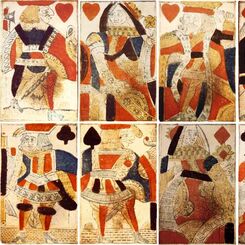
Hunt, c.1800
Standard English pattern playing cards manufactured by Hunt, c.1800.

The Beggars’ Opera
The Beggars’ Opera Playing Cards were first published in 1728. The cards carry the words and music o...

South Sea Bubble
The South Sea Bubble Playing Cards were first published in London by Thomas Bowles in 1720. The card...

Cries of London
The cards were printed from copper plates, with the red suit symbols being applied later by stencil....
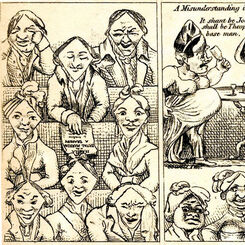
Transformation Playing Cards, 1811
Transformation playing cards, first published in 1811. Each card bears a picture in which the suit m...

Marlborough’s Victories
Marlborough’s Victories playing cards, first published in 1707, depict Marlborough's campaigns and t...
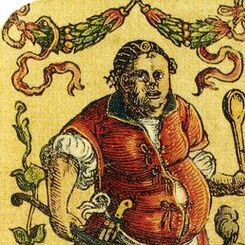
Peter Flötner, c.1545
Seven cards from a satirical pack produced by Peter Flötner of Nuremberg, c.1545. The suit symbols a...

Hewson Replica Pack
Hand-made replica 17th century English playing cards, based on museum originals.

Woodblock and Stencil Playing Cards
Around 1987 I decided to make a pack of playing cards from woodblocks and coloured with stencils. I ...
Most Popular
Our top articles from the past 60 days


 Your comment here. Your comment here. Your comment here. Your comment here. Your comment here. Your comment here. Your comment here. Your comment here. Your comment here. Your comment here. Your comment here. Your comment here. Your comment here. Your comment here. Your comment here. Your comment here. Your comment here. Your comment here. Your comment here. Your comment here. Your comment here. Your comment here. Your comment here. Your comment here. Your comment here. Your comment here. Your comment here. Your comment here. Your comment here. Your comment here. Your comment here. Your comment here.
Your comment here. Your comment here. Your comment here. Your comment here. Your comment here. Your comment here. Your comment here. Your comment here. Your comment here. Your comment here. Your comment here. Your comment here. Your comment here. Your comment here. Your comment here. Your comment here. Your comment here. Your comment here. Your comment here. Your comment here. Your comment here. Your comment here. Your comment here. Your comment here. Your comment here. Your comment here. Your comment here. Your comment here. Your comment here. Your comment here. Your comment here. Your comment here.




















